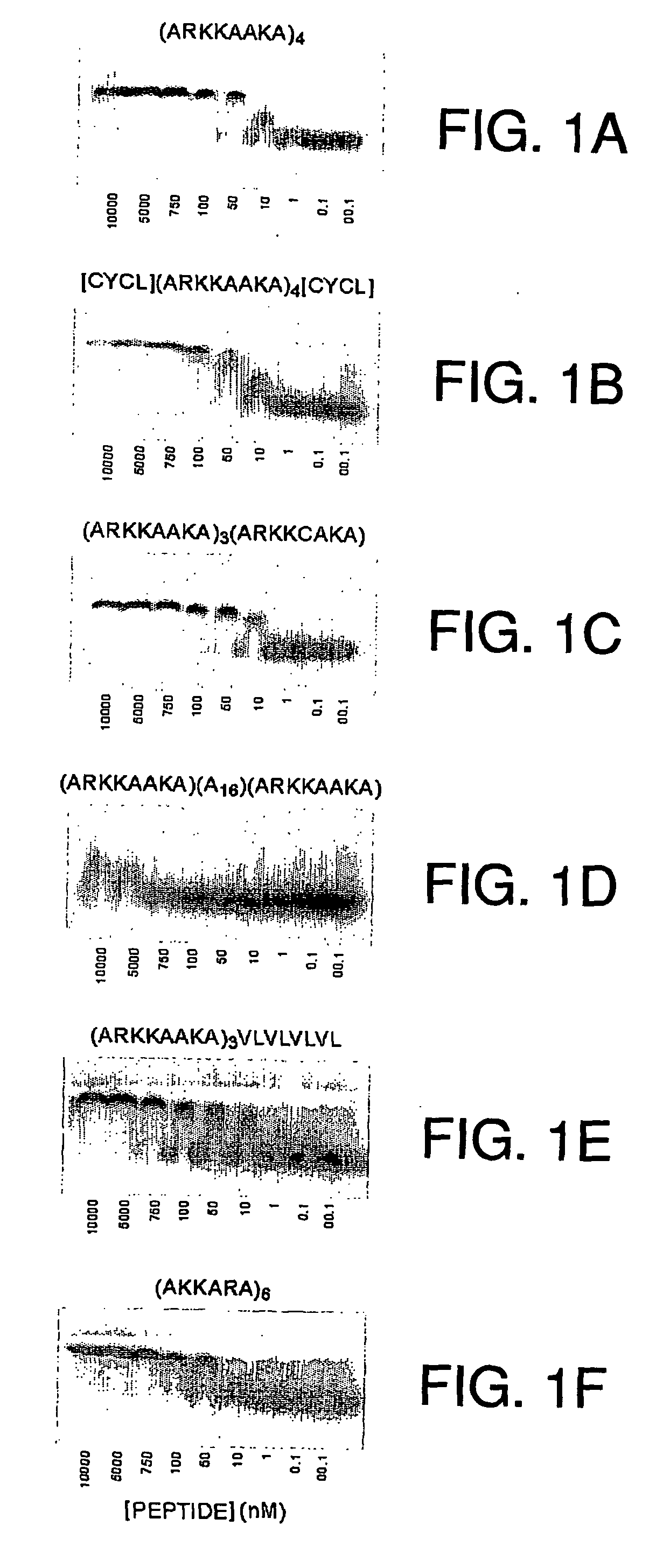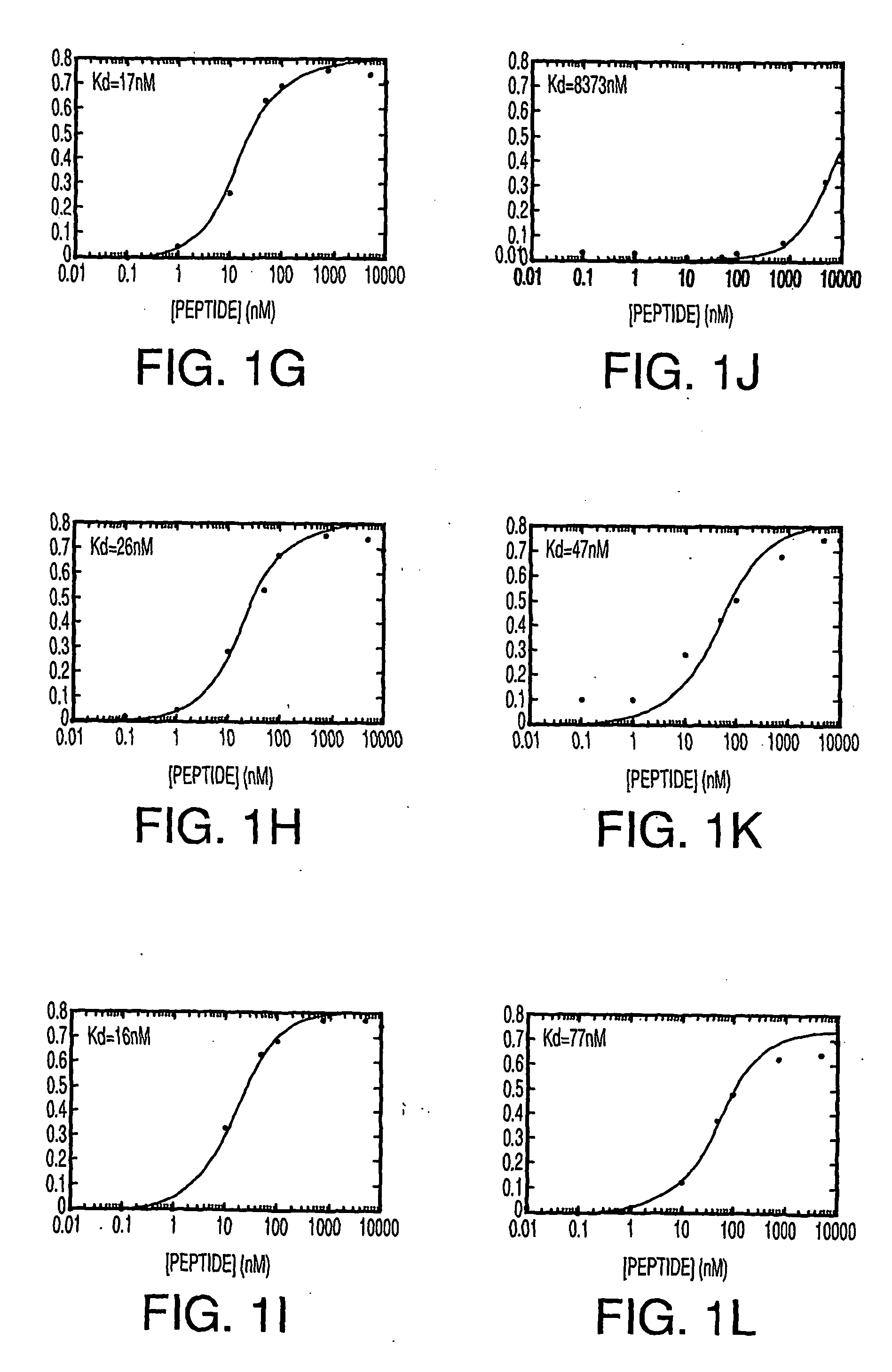Heparin-binding peptides and uses thereof
a technology of heparin and peptides, applied in the field of heparin-binding peptides, compositions, can solve the problems of protamine's adverse hemodynamic and anaphylactic events, significant incidence of serious bleeding, and inability to neutralize ufh's activity, and achieve the effect of reducing the anticoagulant effect of heparin
- Summary
- Abstract
- Description
- Claims
- Application Information
AI Technical Summary
Benefits of technology
Problems solved by technology
Method used
Image
Examples
example 1
Analysis of Heparin-Binding Activity
[0188] Peptide Synthesis. Peptides were synthesized and purified using standard techniques as previously described (WO00 / 45831). Peptides were synthesized by standard solid phase synthesis using FMOC chemistry. Peptide molecular weight was verified by mass spectroscopy, and purity (>70%) analyzed by HPLC.
[0189] Peptide-heparin interactions. The following heparin-binding peptides were synthesized: (ARKKAAKA)4VLVLVLVL (SEQ ID NO:1); (ARKKAAKA)4 (SEQ ID NO:31); cyclized C(ARKKAAKA)4C (SEQ ID NO:34); (ARKKAAKA)3(ARKKCAKA) (SEQ ID NO:33); (ARKKAAKA)(Al6)(ARKKAAKA) (SEQ ID NO:30); (ARKKAAKA)3VLVLVLVL (SEQ ID NO:5); ARKKAAKAARKKAAKAARKKAAKAVLVLVL (SEQ ID NO:7); VLVLARKKAAKAPARKKAAKAVLVL (SEQ ID NO:14); (AKKARA)6 (SEQ ID NO:32); and VLVL(ARKKAAKA)3ARKKCAKA (SEQ ID NO:38).
[0190] Thus, a collection of peptides containing various consensus sequence motifs as described herein, as well as various modifications, was synthesized.
[0191] Preparation of Radiola...
example 2
Neutralizing Heparin Activity
Neutralizing Heparin Activity In Vitro: Effects of Peptides on the Anti-FACTOR Xa Assays in Citrate and in Control Plasma Containing UFH, LMWH or Orgaran®
[0198] The peptides having the sequences of SEQ ID NOs:1, 5, 7, 14, 30-34, and 38 were synthesized as described in Example 1.
[0199] The ability of peptides such as (ARKKAAKA)3VLVLVLVL (SEQ ID NO:5) to neutralize the anti-Factor Xa activity of UFH and LMWH in vitro was tested using the Stachrom Heparin kit (Diagnostica Stago), a standard hematology laboratory assay used to measure the anti-Factor Xa activity of heparin. The assay was performed using the low molecular weight heparin enoxaparin sodium (Lovenox®, Aventis Pharmaceuticals, Inc.), unfractionated heparin (UFH), or the non-heparin glycosaminoglycan danaparoid sodium (Orgaran®, Organon Inc., West Orange, N.J.) in 0.32% citrate or in plasma anticoagulated with 0.32% citrate. Enoxaparin is commonly used clinically as a low molecular weight hepar...
example 3
Platelet Aggregation Studies
[0212] Plasma from six volunteers was tested with various aggregation inducing agents, at several concentrations of each agent, and with six different peptides of the invention. The effect of heparin-binding peptides of the invention on platelet aggregation was determined using standard procedures as previously described. The six peptides which were synthesized and tested were: (ARKKAAKA)4 (SEQ ID NO:31), ARKKAAKA(A16)ARKKAAKA (SEQ ID NO:30), (ARKKAAKA)3ARKKCAKA (SEQ ID NO:33), (ARKKAAKA)3VLVLVLVL (SEQ ID NO:5), C(ARKKAAKA)4C (SEQ ID NO:34), and (AKKARA)6 (SEQ ID NO:32).
[0213] The aggregation-inducing agents tested were: collagen, adenosine diphosphate (ADP), ristocetin, epinephrine, the thrombin receptor peptide SFFLRN, and calcium ionophore A23187. Platelets were subjected to protamine, or to SEQ ID NOS:31, 33, 30, 5, 34, or 32 at 12 μg / ml, and Lovenox® at 0.5 U / ml. Platelet aggregation in response to agonists was monitored and percent aggregation was...
PUM
| Property | Measurement | Unit |
|---|---|---|
| Fraction | aaaaa | aaaaa |
| Fraction | aaaaa | aaaaa |
| Fraction | aaaaa | aaaaa |
Abstract
Description
Claims
Application Information
 Login to View More
Login to View More - R&D
- Intellectual Property
- Life Sciences
- Materials
- Tech Scout
- Unparalleled Data Quality
- Higher Quality Content
- 60% Fewer Hallucinations
Browse by: Latest US Patents, China's latest patents, Technical Efficacy Thesaurus, Application Domain, Technology Topic, Popular Technical Reports.
© 2025 PatSnap. All rights reserved.Legal|Privacy policy|Modern Slavery Act Transparency Statement|Sitemap|About US| Contact US: help@patsnap.com



